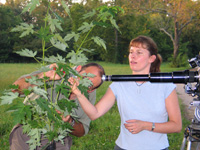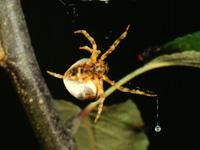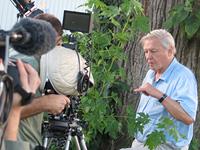UK Spider Research Interests BBC Documentary Filmmakers
UK Spider Research Interests BBC Documentary Filmmakers


The spider drops its silken "bolas" to snare a moth.
Recording amazing wildlife has taken Sir David Attenborough, celebrated British naturalist and BBC broadcaster, to such distant places as the Chimbu Valley in New Guinea, Hood Island in the Galapagos, and the jungles of East Java.
Now add another locale to his world travels: Lexington, Ky.
In early September Sir David and a team of documentary filmmakers from the BBC’s famed Natural History Unit set up cameras at the University of Kentucky’s Spindletop research farm to capture the predatory talents of the bolas spider which feeds at night.

Sir David Attenborough describes the spider's behavior during his on-camera narration.
“With electronic cameras, very low light cameras and infrared cameras, we can film at night,” Attenborough said during an interview with UK Agricultural Communications Services. “There’s a whole new world out there we haven’t been seeing.”
Interview with Sir David Attenborough
The world of the bolas spider has been closely studied for more than 10 years by researchers Ken Haynes and Ken Yeargan, faculty members in the College of Agriculture’s Department of Entomology. The spider gets its name from the unique method it uses to catch moths for food. After dark, it dangles a silken thread with a sticky glob on the end. When a moth approaches, the spider swings this “bolas,” and if the aim is accurate the moth sticks to the glob and can’t escape.
“To attract the moths the spider actually produces a pheromone (sex attractant) for a moth that flies early in the night about two hours following sundown, and then it produces a completely different kind of pheromone for a moth that flies later at night,” said Yeargan. “There really hasn’t been anything that I’m aware of in the area of insect pheromones this sophisticated with regard to predator/prey interactions.”
Discovering this incredible ability of the bolas spider to switch chemical attractants depending on which moth it’s hunting earned international exposure for Yeargan and Haynes’ research programs.
“Our research paper, authored by myself and Ken Yeargan and others, got a lot of publicity in Europe and other places after it was published, and we got requests for pictures of the bolas spider from Germany, the Netherlands, Russia, Israel and Britain,” Haynes said
When the paper’s research findings became a featured story on Nature On-Line, the Internet site of the internationally-renowned Nature Magazine, Haynes was contacted by the BBC.
“They mentioned they were interested in developing a story on bolas spiders that would be in a series called ‘Life in the Undergrowth,’ Haynes said. “Originally they wanted to film in Florida, but because Ken and I are teaching it would be hard for us to get away for any length of time so we thought it would be easier to do it here. Also, the particular species of bolas spider the BBC wanted to film is the one we study here in Lexington.”
A few weeks prior to Sir David and the film unit’s arrival, UK researchers spent many hours and several nights at both Coldstream and Spindletop research farms hunting bolas spiders that would “star” in the documentary.
“There’s an enormous amount of planning that goes into a shoot like this,” said Bridget Appleby, scientist and producer for the BBC’s Natural History Unit. “Our researchers started looking into this story about a year ago. Then, about six month later we made the final decision on which sequences to film. It’s probably taken about three months altogether setting up this shoot, and about three weeks of solid planning in order to get everybody here at the right time with the right equipment.”
Capturing on film the intricate, nocturnal behaviors of the spider presented particular challenges for producer and crew.
“Filming anything at night is difficult because obviously we’ve got to make it look like night, but actually put lights up so we can film the subject,” said cameraman Kevin Flay. “But this spider doesn’t like light at all.”
To work around the problem, Flay put red filter gels over tungsten lights until the spider got comfortable and seemed ready to begin hunting. Then, the crew slowly removed the gels. Occasionally, a tiny earpiece placed near the spider was used to play sound recordings of fluttering moth wings to get the spider to react.
“I’m hoping that shot is going to be great where the bolas comes swinging toward the camera,” said Haynes, who said shooting went smoothly.
While Kevin Flay filmed Sir David and the spider, a second producer/cameraman recorded footage of Haynes and Yeargan interacting with Attenborough and the BBC team, and Haynes said those shots may be included in a “making of” program highlighting behind-the-scenes details of how the main documentary was put together.
Sir David Attenborough’s completed series “Life in the Undergrowth” likely will be available to British audiences sometime in 2006, and American audiences a few months later, according to the BBC.
